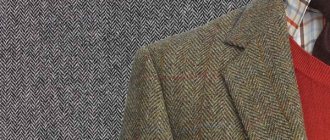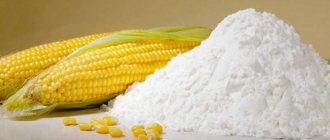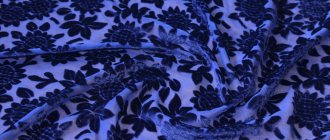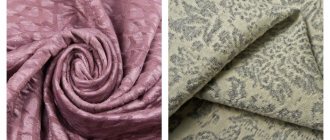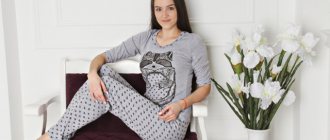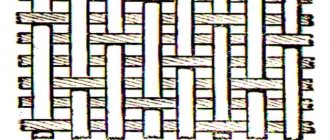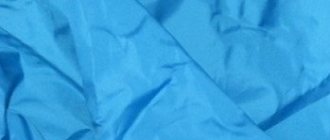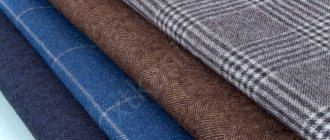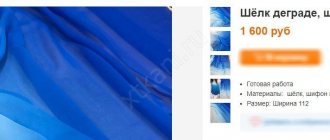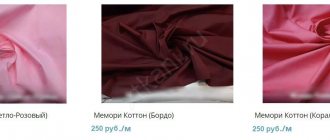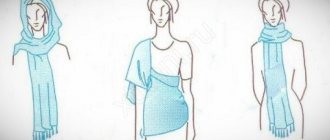Suit, business or festive, summer or warm. There are many requirements for this wardrobe item. Suit fabric must retain its beautiful appearance and shape for a long time, be durable and resistant to pilling and snags. The body must breathe and the fabric must be hygroscopic. Nowadays, the textile industry produces many types of fabrics. In this article we offer you a detailed description of various suit fabrics and their properties. We will tell you what are the important characteristics of fabric for a suit and the areas of application of the materials.
Wool
The composition includes an additive of synthetic components - elastane or polyester. This connection will provide the suit with resistance to wear, strength, and will help retain heat from the surface of the body.
Weaving of several types - twill, patterned and clothes.
Gabardine
A mixture of natural wool and cotton, linen or silk. Refers to expensive fabrics. A cheaper type of mixed fabric made of wool and polyester.
They retain heat less well, but are not inferior in strength and wear resistance.
The most commonly used in the clothing industry are:
1. Wool and elastane. Trousers made of this fabric will not stretch out at the knees and practically do not wrinkle.
2. Wool and viscose. Long-term deformation-resistant fabric with a diagonal rib on the surface.
3. Cheviot. Suit wool with viscose or cotton. Inexpensive, warm twill weave fabric.
Advantages of natural wool and blended fabrics:
- Good air circulation and at the same time long-term retention of heat from the body.
- Sweat and moisture are quickly absorbed and quickly evaporate.
- Low creasing, practically no creases or wrinkles form on the surface. Therefore, wool fabric for jackets and trousers is an ideal solution.
- Long term wear of items made from these materials.
- Good resistance to prolonged exposure to ultraviolet rays.
- The suits can withstand a large number of abrasion cycles.
- Do not lose surface quality and color brightness when washed with aggressive chemicals.
Let's talk about the composition
Purely natural fibers are used to sew business clothes: wool, linen, and cotton. Wool is the leader among these fabrics. Its properties can be different, it all depends on the thinness of the thread.
You can find out the quality of the material by its markings. Usually, the numbers 100's, , 120's, 220's are indicated on each label.S is abbreviated as “spesori”. This word refers to a value indicating how many kilometers of thread were drawn from 1 kilogram of wool.
The size of a spesori is similar to a diamond carat. The higher the number, the better and more expensive the material.
Viscose
This suiting fabric is obtained by combining viscose with polyester fibers to give the fabric greater strength, elasticity and hygroscopicity.
Suits made from viscose are also easy to care for.
This fabric also has advantages:
- Light weight of the finished suit.
- There is no accumulation of static electricity.
- For clothes made from this fabric, a big plus is that pills do not appear on it after prolonged wear.
- The original brightness of the color is maintained after many washes.
Minuses
- This fabric is very demanding to care for and if the recommendations are not followed, it quickly becomes unusable.
- It wrinkles a lot.
- When stretched while wet, it quickly loses its shape.
- The color loses its brightness with prolonged exposure to sunlight.
- Shrinkage in size is allowed.
- In order to eliminate these disadvantages, impregnation of the fabric with special compounds is required.
Artificial and synthetic fibers
Viscose is a man-made fiber made from wood cellulose. Women especially love clothes made of viscose for its softness and beautiful shine. The material is light and hygroscopic, easy to care for. For business clothes today, polyviscose made from a mixture of viscose and polyester is increasingly used.
Polyviscose has properties similar to cotton, but they have the same base - cellulose. It has many valuable properties that distinguish mixed materials:
- good elongation without loss of shape - stretched fibers easily return to their original form;
- durability and wear resistance due to the addition of polyester;
- hygroscopicity;
- comfort to wear, softness and tenderness;
- hypoallergenic - people with allergies to wool can wear clothes made of polyviscose.
Cotton
With synthetic components, dresses made from suit fabric fit the figure, allow the body to breathe and do not create discomfort in movement. Natural fabrics are rarely used when sewing suits, since cotton is not dense enough for suits and does not hold its shape.
pros
- Natural fabric. Will not cause allergies or skin irritation.
- Hygroscopicity.
- Durable fabric for a suit.
Flaws
- The need to treat things with special compounds to reduce creasing.
- The appearance of microorganisms in the tissue structure, which over time gradually destroy the tissue.
Production
A variety of types of wool are used to make fabrics. The quality of the yarn is different, and, therefore, the fabric has different properties. The most famous are the following types of wool.
Sheep is the most common and affordable. Sheep wool provides excellent warmth, is wear-resistant and durable.
Sheep's wool
There are several subtypes of material:
- Lamb's wool is the wool of the first shear. Unusually soft to the touch, thin and obedient. Readily used in the manufacture of costume fabrics of all types;
- merino - the covering of a fine-fleeced Merino sheep. It is distinguished by softness and lightness. It costs a little more, but heats better. You might like a knitted merino wool blanket;
- Shetland - very wear-resistant, but rough-looking wool, very warm, but tough. Often used for sewing casual jackets;
- Cheviot – durable, warm, quite hard and rough. This is the basis of all tweeds for men's and women's suits.
Angora is the wool of Angora rabbits. Extraordinarily soft and pleasant, has a beautiful shine, but is prone to shrinkage. Not applicable for suit fabrics. Follow the link to find the composition of angora fabric.
Angora wool
Camel - light, durable, elastic, usually combined with sheep wool. Ideal material for sweaters, coats. You may be wondering how to choose a camel wool blanket.
Camel's wool
Vicuna is one of the varieties of camel, very thin and soft, hand-picked and very expensive. Used in the production of the most expensive suit fabrics.
Vicuna wool
Cashmere is made from the wool of Himalayan goats. Very soft, thin, delicate fiber, and at the same time it has very high wear resistance. It is used everywhere despite the hefty cost. Here is a detailed description of cashmere suiting fabric.
Wool Cashmere
Mohair is the wool of the Angora goat. Rougher than Angora, but light and durable, it also has a beautiful shine. Mohair fabrics are used to sew outerwear, suits and even tuxedos.
Wool Mohair
Alpaca wool is one of the llama breeds. Unusually warm - noticeably warmer than merino or cashmere, extremely light, has a soft shine. Alpaca material is used for expensive clothing.
Alpacas
Barbie
So what kind of fabric is Barbie? Excellent draping fabric with a rough surface and crepe weave threads. Elastic, polyester or viscose is also added to the composition. The material is dense and does not crumble. Shimmers slightly when moving.
Due to its dense double-sided surface, Barbie material is often used in tailoring costumes.
Advantages
- Things are neat and look expensive.
- The fabric is dense and strong.
- Doesn't break, doesn't wrinkle.
- Fits beautifully to the figure. Barbie fabric stretches very well.
- Resistant to snags.
- Does not allow moisture to pass from outside.
Minuses
- Low air infiltration.
- Does not withstand prolonged exposure to sunlight.
- The item may become deformed if washing instructions are not followed.
Linen
Linen is a hygienic fabric with good antibacterial, hygroscopic, and ventilated properties. However, using it in its pure form for sewing things in a business style is unprofitable. It is not durable, wrinkles easily and is difficult to smooth out. Therefore, its composition often contains viscose and polyester additives. This ensures resistance to mechanical damage, strength, and wear resistance.
For suits, plain-dyed, bleached and gray fabrics are used. Their appearance is varied. They can be openwork, imitate hemstitching, have a jacquard effect, or have a relief surface.
Gozhka
It is used in the textile industry for sewing jackets, trousers, skirts, jackets more often than others. A distinctive feature is a checkerboard weave, which gives it a resemblance to burlap. Polyester and elastane fibers improve the original characteristics of the material. She acquires:
- Resistant to deformation. Keeps its shape well even with everyday use.
- Inert to absorb odors. This ensures hygiene, although many women consider this quality a disadvantage. Even the most expensive perfumes and eau de toilette do not last long on matting.
- High strength. It is almost impossible to tear such fabric, but the fabric has a loose structure, which leads to easy formation of snags.
Among the disadvantages of matting, professional seamstresses highlight the complexity of the work. Its ends are very frayed. This causes difficulties when cutting.
For your information: Coco Chanel introduced the fashion for matting. The stylish madam had amazing taste that has stood the test of time. Today in Europe, most businessmen and businesswomen prefer this material.
Linen
Since the fabric has a loose structure and flowability, it is used when sewing lightweight flight suits. The body in linen clothes breathes and does not sweat. Polyester added to the fabric helps eliminate severe creasing and make linen clothing easier to care for.
Linen-gabardine
Unlike all-natural flax, this mixed version wrinkles less and retains its original shape and attractive appearance well. Often used in sewing summer suits.
Material classifications
The heterogeneity of the paintings led to their division into groups. The classifications are based on different criteria.
| Main feature | Groups |
| By fiber composition | For sewing business clothes use:
|
| According to the structure of threads and yarn | This feature affects the properties and appearance of the fabric:
|
| By color | The color palette is wide. Stand out:
For women, jacquard fabrics with a convex pattern or double-sided varieties with contrasting colors are mainly used. Among men's suits, the leading ones are the herringbone pattern and shanzhan (a special effect in which the fabric shimmers). |
| According to fabric structure | Almost all types of weaves are used in production. The most common is finely patterned weaving. |
| By gender | Men's models are most often made of pure wool and wool blend varieties. Women's wardrobe for the office is distinguished by softer, more delicate, lightweight fabrics. For children's products, high-quality mixed materials are preferable. Their advantage is practicality and durability. |
| By season | Summer suits are made from hygroscopic, breathable, lightweight fabrics. Good thermal insulation properties are important for winter. |
| By purpose | There are different suits and suits; this must be taken into account when choosing. Products are:
|
Note: There is an unspoken classification based on cost: budget and premium models. The main indicator here is composition. The more natural fibers, the higher the price. The cheapest are synthetic varieties.
Cashmere
Very thin material, twill weave. The finest premium quality mountain goat yarn. Cashmere items are never cheap. This material has many advantages.
- Things are almost weightless, thin. A cashmere sweater can easily be threaded through a small ring.
- Environmental friendliness of the material. Unlike synthetic analogues, dust mites will not appear in the structure and clothing will not cause allergic reactions on the skin.
- Cashmere, despite its thinness, is very dense and resistant to deformation.
- Suit wool has a low level of thermal conductivity, which means that the body will not freeze and the skin will breathe.
- Since the material is very thin and soft, things do not pinch or cause discomfort when worn.
Flaws
- After prolonged wear, pellets appear in places where surfaces touch. Therefore, it will be necessary to periodically clean the areas under the arms and on the belt.
Cotton
Pure cotton is rarely used for the production of suits. It has high hygienic properties, but is fragile and subject to wear. Artificial additives come to the rescue. Elastane, polyester, and viscose increase its elasticity, reduce wrinkles, and make the material durable.
Options with plain and twill weave are popular for creating a business wardrobe. Most often, denim and pile varieties play this role.
Pile
Characterized by small additions of lavsan and polyester. Their distinctive feature is a small fluff on the front side.
Please note: The pile gives the product a velvety, soft feel and causes a pleasant tactile sensation.
This group is heterogeneous in its composition. It has many options.
| Fabric name | Subspecies | Properties |
| Velvet | Highlight: 1. Actually velvet. It has a low, thick pile. 2. Velvet stretch. Lycra is added to it, as a result it gets good stretchability, but does not add additional volume. Even plump people look slim in such clothes. 3. Velvet chameleon. It has the ability to change shades depending on the lighting or the location of the fibers when creating a pattern. 4. Panvelvet. Dearest. The unusual texture is due to the compacted pile. | Stylish and expensive. Dense, but does not create pressure on the shoulders. Relevant for elegant clothing – suits for women and jackets for men. |
| Velveteen | Depending on the type, the purpose of the canvas is determined: 1. Velvet cord. Dense appearance with thick stripes. Indispensable for warm jackets and jackets. 2. Corduroy ribbed. Thinner, suitable for creating demi-season suits, skirts, trousers. | The material is valued for its interesting texture - it has longitudinal scars. Stretches well and is resistant to stains. |
| Covercott | You can often find jackets made from carpet. An excellent option for spring and winter, since, thanks to their moisture-repellent properties, such products are not afraid of rain. They are practical, comfortable to wear, and do not require ironing. |
Note: Cotton varieties of suiting fabric look sophisticated and elegant. They do not accumulate static electricity, do not cause allergies, and are suitable for wearing even in warm weather.
Denim
Gone are the days when denim was not highly valued and served as a raw material for making clothes for American farmers.
Today, high-quality denim items indicate good taste and a desire to be in trend.
During the production process, lavsan is added to natural fibers. This makes the material elastic and almost wrinkle-resistant, which is why most men and women love denim.
In addition, it is diverse both in appearance and composition.
| Varieties | Properties and Application |
| Denim-silk | Lightweight, despite its density, matter. A distinctive feature is a muted shine. Relevant for classic trousers and children's clothes. |
| Jeans-linen | Composed of 50/50 cotton and linen threads. This type is used for women's demi-season clothing. |
| Jeans luxury | It makes great outfits. The shiny surface and the absence of small scars provide jackets, skirts, and trousers with a stylish appearance. |
| Stretch jeans | It is often chosen by young people who love tight-fitting clothes. Drapes well. |
Important: Denim items cannot be dry cleaned. They will lose their shape and shrink. You shouldn't even pet them. When exposed to high temperatures, they can lose their shine and lose color saturation.
Features of care
They largely depend on the composition, so you need to study the recommendations on the label. Among the basic rules is refusal to wash at home, especially with the use of active chemicals. It is better to take the product to a professional dry cleaner.
When ironing, use an additional layer of cloth. But there is one nuance here: if the label says dryclean, the item cannot be ironed or steamed. Otherwise it will lose its shape.
Suit fabrics will always be in fashion, because products made from them are stylish and beautiful. They do not require complicated maintenance and last a long time. With the advent of new, technologically advanced samples, the range is expanding, which means that in the near future we will have many models made from modern varieties of materials.
Basic requirements for costume materials
All fabrics for sewing business clothes must have certain properties. Such products are expensive and are purchased for more than one year. Failure to comply with standards can lead to rapid wear and tear or loss of appearance. Among the main requirements:
- Form stability. This is achieved through special styles. The lining, which can be glued, solid, or present in the area of certain parts (shelves, sleeves), is also of great importance. Sometimes shoulder pads are used for better relief.
- Strength. Fabrics should not tear easily or succumb to abrasion. This is especially true for elbows.
- Ventilation. The skin must breathe even in thick clothing, this eliminates the formation of the greenhouse effect. At the same time, the fabric must create an optimal microclimate, that is, retain heat and prevent the body from becoming overcooled.
- Aesthetic appearance. It includes resistance to pilling and quality coloring. Even with frequent wear, pockets, areas around buttons, and wrists should remain smooth, without pilling. High-quality material retains the richness of the color palette even after repeated dry cleaning.
If all these characteristics are present, the purchased suit will last for several seasons.
